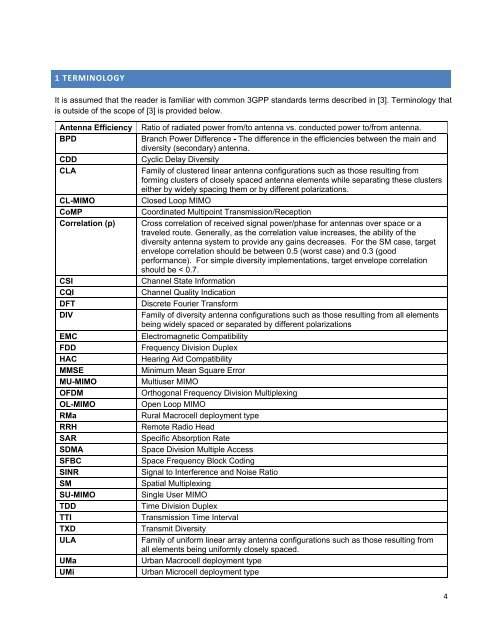MIMO Transmission schemes for LTE and HSPA Networks, 3G
MIMO Transmission schemes for LTE and HSPA Networks, 3G
MIMO Transmission schemes for LTE and HSPA Networks, 3G
- No tags were found...
Create successful ePaper yourself
Turn your PDF publications into a flip-book with our unique Google optimized e-Paper software.
1 TERMINOLOGYIt is assumed that the reader is familiar with common <strong>3G</strong>PP st<strong>and</strong>ards terms described in [3]. Terminology thatis outside of the scope of [3] is provided below.Antenna EfficiencyBPDCDDCLACL-<strong>MIMO</strong>CoMPCorrelation (p)CSICQIDFTDIVEMCFDDHACMMSEMU-<strong>MIMO</strong>OFDMOL-<strong>MIMO</strong>RMaRRHSARSDMASFBCSINRSMSU-<strong>MIMO</strong>TDDTTITXDULAUMaUMiRatio of radiated power from/to antenna vs. conducted power to/from antenna.Branch Power Difference - The difference in the efficiencies between the main <strong>and</strong>diversity (secondary) antenna.Cyclic Delay DiversityFamily of clustered linear antenna configurations such as those resulting from<strong>for</strong>ming clusters of closely spaced antenna elements while separating these clusterseither by widely spacing them or by different polarizations.Closed Loop <strong>MIMO</strong>Coordinated Multipoint <strong>Transmission</strong>/ReceptionCross correlation of received signal power/phase <strong>for</strong> antennas over space or atraveled route. Generally, as the correlation value increases, the ability of thediversity antenna system to provide any gains decreases. For the SM case, targetenvelope correlation should be between 0.5 (worst case) <strong>and</strong> 0.3 (goodper<strong>for</strong>mance). For simple diversity implementations, target envelope correlationshould be < 0.7.Channel State In<strong>for</strong>mationChannel Quality IndicationDiscrete Fourier Trans<strong>for</strong>mFamily of diversity antenna configurations such as those resulting from all elementsbeing widely spaced or separated by different polarizationsElectromagnetic CompatibilityFrequency Division DuplexHearing Aid CompatibilityMinimum Mean Square ErrorMultiuser <strong>MIMO</strong>Orthogonal Frequency Division MultiplexingOpen Loop <strong>MIMO</strong>Rural Macrocell deployment typeRemote Radio HeadSpecific Absorption RateSpace Division Multiple AccessSpace Frequency Block CodingSignal to Interference <strong>and</strong> Noise RatioSpatial MultiplexingSingle User <strong>MIMO</strong>Time Division Duplex<strong>Transmission</strong> Time IntervalTransmit DiversityFamily of uni<strong>for</strong>m linear array antenna configurations such as those resulting fromall elements being uni<strong>for</strong>mly closely spaced.Urban Macrocell deployment typeUrban Microcell deployment type4
















